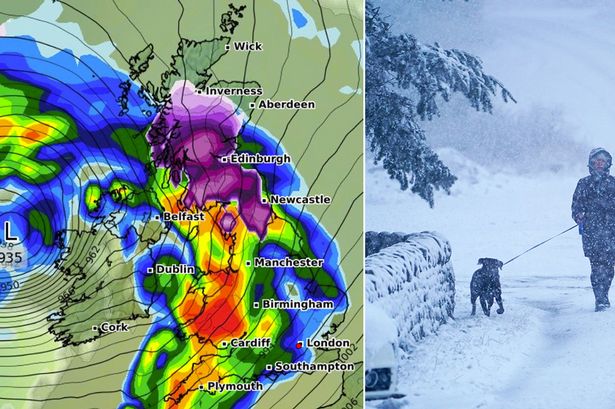The UK is bracing for a significant meteorological event as Storm Éowyn, a potent low-pressure system, barrels towards its shores. The Met Office has issued severe weather warnings, forecasting ferocious winds exceeding 90 mph in certain regions. These extreme gusts have the potential to wreak havoc, causing widespread disruption to transport networks, power outages, and damage to infrastructure. Coastal areas are particularly vulnerable, with the risk of large waves and coastal flooding. The intensity and trajectory of the storm are being closely monitored, and authorities are urging residents to take necessary precautions to safeguard themselves and their property.
In addition to the ferocious winds, Storm Éowyn is also predicted to bring substantial snowfall to parts of the UK. The latest weather maps illustrate a swathe of heavy snow accumulating, especially across higher ground and northern regions. This heavy snowfall presents a further set of challenges, likely exacerbating travel disruptions and potentially isolating communities. Mountainous areas are at risk of blizzard conditions, with visibility severely reduced by driving snow and strong winds. The combination of heavy snow and gale-force winds creates a dangerous scenario, posing significant risks to both life and property.
The development and progression of Storm Éowyn are being closely monitored by meteorologists, utilizing advanced weather models and satellite imagery to provide the most accurate and timely forecasts. The projected path of the storm suggests a rapid eastward movement across the UK, with the strongest winds expected along exposed coastlines and higher elevations. The precise timing and intensity of the storm’s impact will vary regionally, and residents are advised to stay updated with the latest Met Office warnings and local news reports for specific guidance in their area.
The impending storm underscores the importance of preparedness and resilience in the face of extreme weather events. Authorities are urging residents to take proactive steps to mitigate potential risks, such as securing loose objects outdoors, ensuring adequate supplies of essential items like food and medicine, and having a plan in place for communication and evacuation if necessary. Businesses and organizations are also encouraged to review their contingency plans and take measures to protect their assets and operations.
The impact of Storm Éowyn is expected to be widespread and multifaceted. Travel disruptions are almost certain, with road closures, flight cancellations, and delays to rail services likely. Coastal communities face the threat of flooding and erosion due to powerful waves and storm surges. Power outages are also a significant concern, as strong winds can damage power lines and disrupt electricity distribution networks. The combined impact of high winds and heavy snow will pose a challenge for emergency services responding to incidents and providing assistance to affected communities.
Beyond the immediate impacts, Storm Éowyn highlights the growing concern about the increasing frequency and intensity of extreme weather events, potentially linked to climate change. As the planet warms, the atmosphere holds more moisture, leading to heavier rainfall and snowfall. Changes in atmospheric circulation patterns can also contribute to more powerful storms and unpredictable weather patterns. The impact of Storm Éowyn serves as a reminder of the need for ongoing investment in climate resilience and adaptation measures, to protect communities and infrastructure from the increasing risks posed by a changing climate. This includes strengthening infrastructure, developing early warning systems, and implementing sustainable land management practices to reduce vulnerability to extreme weather events.














